- Created by Kilian Jahn, last modified on 10 12, 2021
You are viewing an old version of this page. View the current version.
Compare with Current View Page History
« Previous Version 2 Next »
Overview
This page describes in detail which software, and their respective versions, was used to generate und use the module demonstration.
Further described is how to flash the Hardware and Software Design contained in the Demo Archieve onto the TEM0001.
A brief usage introduction for each Demo is included.
The Hardware Reference Design uses these Smartfusion 2 SoC, hard Arm® Cortex®-M3 Core, Soft SDRAM Core, Soft SPI Core, COM port, Real Time Clock and the on-board LEDs via a Soft PWM Core.
The Software Designs Hello World, SF2_GNU_SC4_pwm_slow_blink and SF2_GNU_SC4_rtc_time use the Hardware Design features to a different degree. Most notably is Hello World, which utializes all features of the Hardware and is very close to the modules production test.
Refer to UPDATE-LINK/LinkText:_TEM00XY-Resources UPDATE
for the current online version of this manual and other available documentation.
Key Features
- Libero 2021.2 (FPGA IDE)
- SoftConsole 2021.1 (Software IDE)
- UART
- SDR
- eNVM
- User LED access
- Real Time Clock
Revision History
| Date | Libero | SoftConsole | Project Built | Authors | Description |
|---|---|---|---|---|---|
| 2021-12-09 | 2021.2 | 2021.1 | NAME-OF-ZIP-ARCHIVE .zip | Kilian Jahn |
|
Release Notes and Know Issues
Non known so fare.
Requirements
Software
| Software | Version | Note |
|---|---|---|
| Windows 10 | 2004 / 19041 | |
| Libero Release | 2021.2 | |
| SoftConsole | 2021.1 | Included in the Libero installation |
| Microsemi Flash Pro 5 module driver | 2.10.0.0 | Utilize onboard programmer and USB / COM port connection. Included in the Libero installation |
| FTDI Driver for the TEM0002 module | 2.12.28.0 | |
| UART / COM-port terminal | Capturing the modules messages |
Hardware
Design supports following modules:
| Module Model | Board Part Short Name | PCB Revision Support | DDR | embedded SRAM | embedded Flash | Notes |
|---|---|---|---|---|---|---|
| TEM0001-01A-010C | SMF2000 | REV01 | 4 MB a 16 bit | 64 kB | 256 kB | NA |
Additional hardware Requirements:
| Additional Hardware | Notes |
|---|---|
| Demo host computer | Demo was created and tested on windows |
| Micro USB to USB Type A Cable | Power supply, JTAG: Programming the board, UART: Communication Interface to the board. |
Content
The Trenz Electronic Reference Designs and Demos are usable with the specified Microsemi Libero / SoftConsole version. Usage of a different Microsemi Libero / SoftConsole software versions is not recommended.Download
The download is a ZIP compressed archive, it needs to be extract before usage.
Recommendation :
The path of the extracted archiev is vital for all IDE's, therefore place the extracted archiev outside the user space, e.g. "c:\Extracted_Archieve" [ Access rights / Path length limit ].
Reference Designs / Demos are available via the following link:
Design Sources
Content of the zip archive "TEM0001-RefDes_V2_0x.12.2021-1923" :
| Type | Location | Notes |
|---|---|---|
| Libero | <zip archive> / Libero2021.2_Hardware-Design | Libero Project containing the modules |
| SoftConsole | <zip archive> / SoftConsole2021.1_Workspace_TEM0001 / helloWorld / SF2_GNU_SC4_pwm_slow_blink / SF2_GNU_SC4_rtc_time | SoftConsole Workspace
|
| SoftConsole | <zip archive> / SoftConsole2021.1_Workspace_TEM0001 / microsemi-cortex-m3.cfg | File for software debugging in |
| FlashPro Express | <zip archive> / FlashProExpress2021.2 / RefDes02 / RefDes02-HelloWorld / RefDes02-Zerocitation | Programming Files to use in FlashPro Express. Omittes the usage of Libero and SoftConsole for Programming.
|
Launch
Executing a Reference / Demo Design on a module requires the powering of it and a JTAG or UART Connection for Programming and Communication. Often the programming is a two fold process, where the first programming configures the FPGA and the second programming flashes Software code to be executed inside the FPGA / ARM processor.
Connecting
Select a variant!
Variant without explicit power connector:
Connect the modules TYPE USB to your host pc, this enables the powering of the module and a simultaneous JTAG and UART connection .
Variant with explicit power connector:
Connect the modules TYPE USB to your host pc and power the module via its dedicated power connector (e.g. Power Jack 5 V / 2 A + inside), this enables the powering of the module and a simultaneous JTAG and UART connection .
Insert picture to ilustarte the needed connections USB/Ethernet/Power jack/... (AD-TE000XY-... .PDF / schematic picture)
Driver check
When the module is connected via USB cable to your demo host computer, in the Windows Device Manager appear the following three board driver related devices:
In section Ports (COM & LPT):
- FlashPro5 Port (ComX)
In section Universal Serial Bus controllers:
- USB FP5 Serial Converter A
- USB FP5 Serial Converter B
The Device Manager is accessible via "Right mouse click context menu" from the Windows Start Menu Button. When these devices are not visible, the driver installation through libero could be faulty.
Programming Hard and Software Designs
Before flashing any design to the module, open a terminal programm (e.g. PuTTY or SmarTTY) to the boards COM port, so that when the module restarts after programming, it's messages can be captured.
Programming Variant "IDE"
The Microsemi Hardware and Software Design Tools, Libero and SoftConsole, incorporate the abillity to edit, debug and program Hardware and Software Designs. This Programming Variant is for you, when you are interessted in this.
Programming the Hardware design
To program the Hardware Reference Design Programming, open FPGA Design IDE Libero.
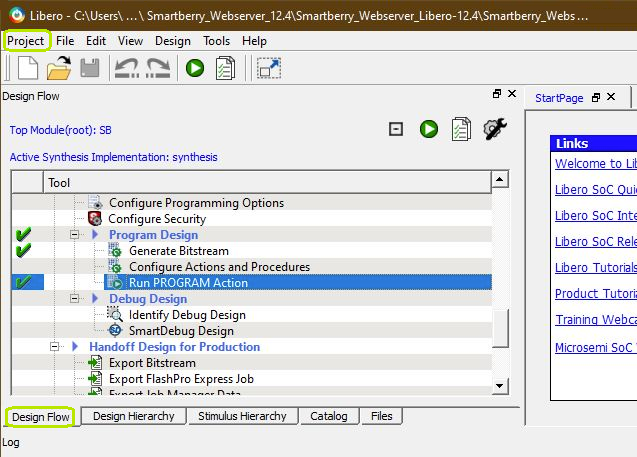
The Hardware Reference Design can be opened via "Project > Open Project" in the top right corner of Libero (picture above - upper green rectangle). A file dialogue opens, point the dialogue along the extracted download to the folder containing the Hardware Reference Design.
Disk :\ Path-to-the-Demo-archive \ Extracted ZIP-archive \ Libero-X.y_Referenz-Design\
Double left mouse click onto the project file "Referenz-Design_XY .prjx" to open it. The board is automatically selected and setup to be flashed by Libero.
In the upper left section of Libero, select the tab "Design Flow" (picture above - lover green rectangle) and flash it to the board via "Program Design > and double left mouse click onto "Run PROGRAM Action" (picture above - row with blue background).
Warnings should not affect the functionality of a Reference / Demo -Design.
Programming a Software project
Open SoftConsole and press "Browse..." near the right edge. A file dialogue opens, point the dialogue along the extracted download to the folder containing the SoftConsole Workspace.
Disk :\ Path-to-the-Demo-archive \ Extracted ZIP-archive \ Softconsole-X.y-Workspace \
Confirm your selectioin by pressing "Ok" , the dialogue closes, and open The SoftConsole by pressing "Launch"
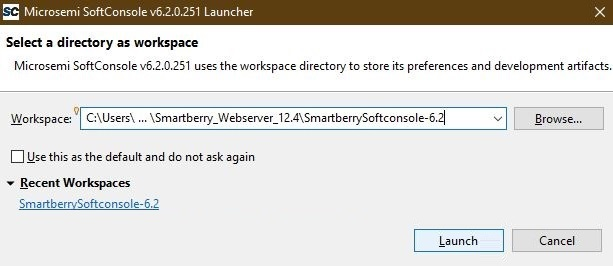
Subsequently the program opens and shows the software project's who are contained inside the workspace to the left, under "Project Explorer".
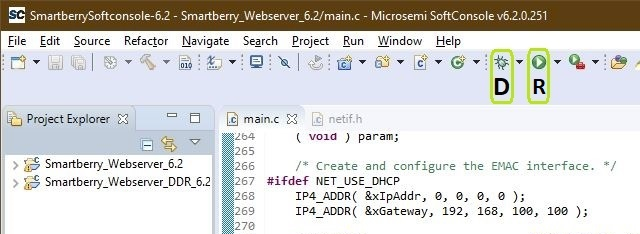
To simply run a Project, press the triangle right to the button marked with a "R" in the picture above and select a variant of the demo.
Pressing the triangle next to the button marked with "D" let you select which variant to be executed in debug mode.
Debug controls - Resume - Pause - Stop
Switch between Debug and Run perspective (upper right corner program window)
![]()
Programming Variant "FlashPro Express"
When you just want to run a SoC Design, this is for you.
To program a Hardware and Software Design simultaneously, open FlashPro Express. Via left click onto Open .... in the section "Job Projects" open a file dialogue. Point to
Disk :\ Path-to-the-Demo-archive \ Extracted ZIP-archive \ FlashProExpressX.y \ Desired Demo \ JobFile . pro
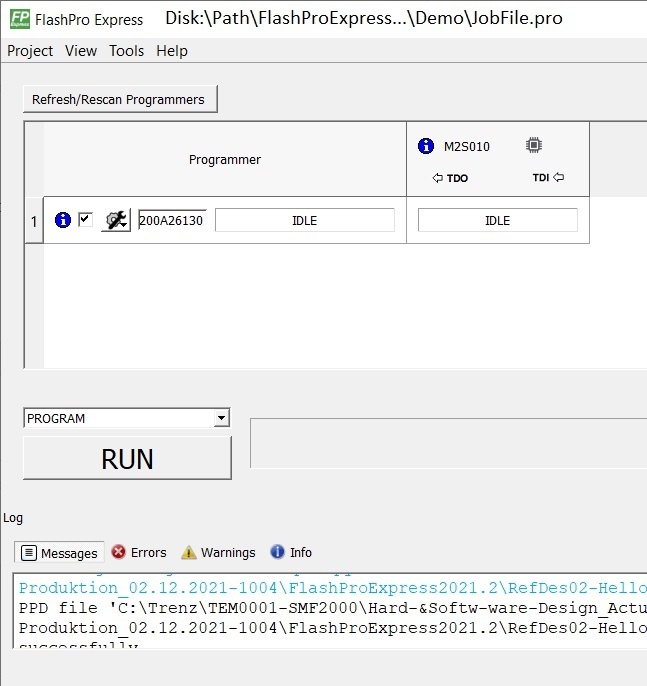
To program the Design, press Run.
Hardware Reference Design - Libero
Smart Design
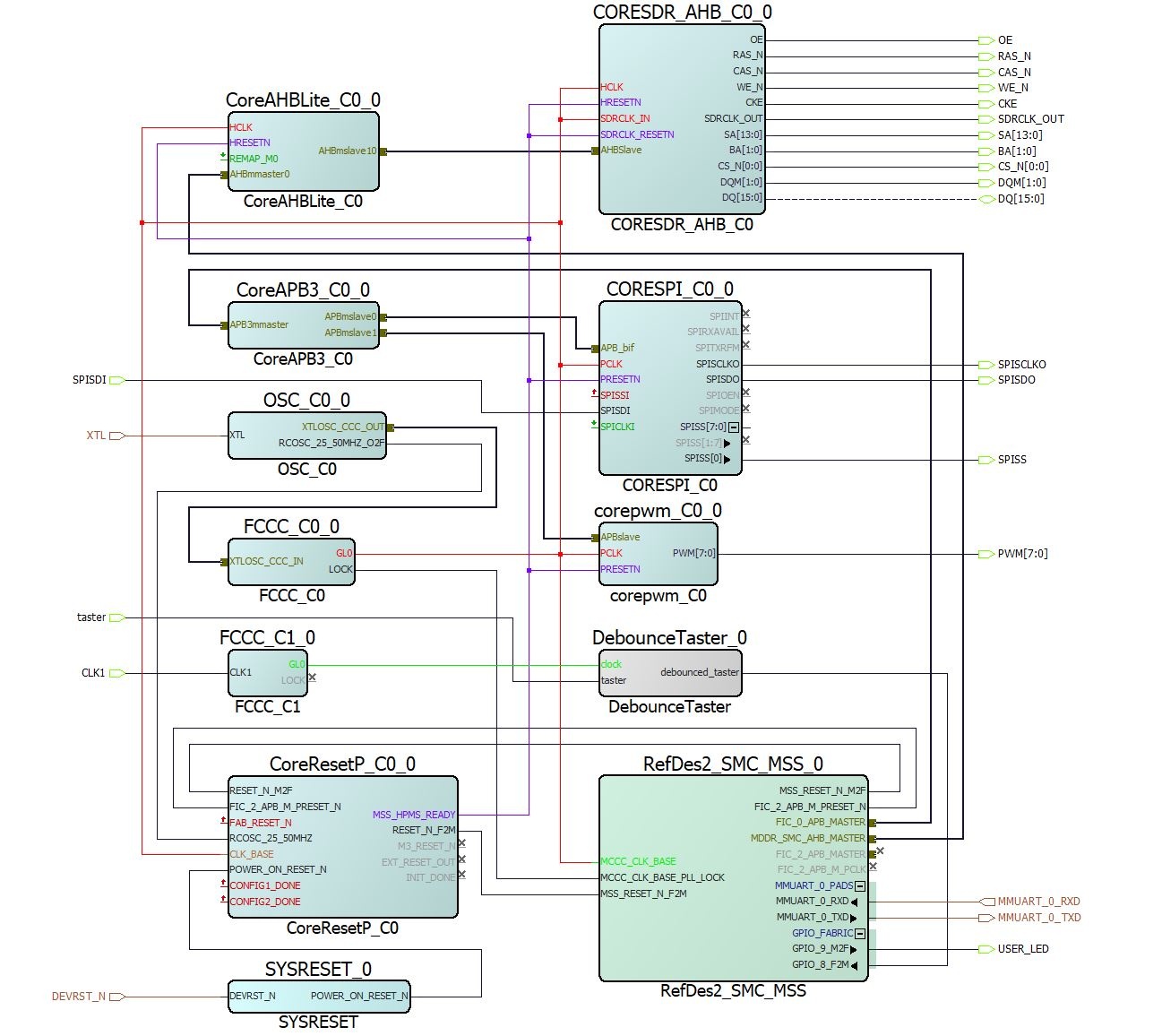
Constrains
IO constrains
# Microsemi I/O Physical Design Constraints file
# User I/O Constraints file
# Version: v2021.1 2021.1.0.17
# Family: SmartFusion2 , Die: M2S010 , Package: 400 VF
# Date generated: Fri Aug 13 07:56:00 2021
#
# User Locked I/O Bank Settings
#
#
# Unlocked I/O Bank Settings
# The I/O Bank Settings can be locked by directly editing this file
# or by making changes in the I/O Attribute Editor
#
#
# User Locked I/O settings
#
#
# Dedicated Peripheral I/O Settings
#
set_io CLK1 \
-pinname N16 \
-fixed yes \
-DIRECTION INPUT
#
# Unlocked I/O settings
# The I/Os in this section are unplaced or placed but are not locked
# the other listed attributes have been applied
#
#
#Ports using Dedicated Pins
#
set_io DEVRST_N \
-pinname U17 \
-DIRECTION INPUT
set_io XTL \
-pinname Y18 \
-DIRECTION INPUT
# Microsemi I/O Physical Design Constraints file
# User I/O Constraints file
# Version: v11.8 11.8.0.26
# Family: SmartFusion2 , Die: M2S010 , Package: 400 VF
# Date generated: Fri Oct 20 14:01:01 2017
#
# User Locked I/O Bank Settings
#
#
# Unlocked I/O Bank Settings
# The I/O Bank Settings can be locked by directly editing this file
# or by making changes in the I/O Attribute Editor
#
#
# User Locked I/O settings
#
set_io {BA[0]} \
-pinname W10 \
-fixed yes \
-DIRECTION OUTPUT
set_io {BA[1]} \
-pinname V12 \
-fixed yes \
-DIRECTION OUTPUT
set_io CAS_N \
-pinname Y12 \
-fixed yes \
-DIRECTION OUTPUT
set_io CKE \
-pinname Y13 \
-fixed yes \
-DIRECTION OUTPUT
set_io {CS_N[0]} \
-pinname R13 \
-fixed yes \
-DIRECTION OUTPUT
set_io {DQ[0]} \
-pinname F1 \
-fixed yes \
-DIRECTION INOUT
set_io {DQ[1]} \
-pinname G1 \
-fixed yes \
-DIRECTION INOUT
set_io {DQ[2]} \
-pinname E2 \
-fixed yes \
-DIRECTION INOUT
set_io {DQ[3]} \
-pinname G2 \
-fixed yes \
-DIRECTION INOUT
set_io {DQ[4]} \
-pinname E3 \
-fixed yes \
-DIRECTION INOUT
set_io {DQ[5]} \
-pinname G3 \
-fixed yes \
-DIRECTION INOUT
set_io {DQ[6]} \
-pinname F3 \
-fixed yes \
-DIRECTION INOUT
set_io {DQ[7]} \
-pinname F4 \
-fixed yes \
-DIRECTION INOUT
set_io {DQ[8]} \
-pinname J7 \
-fixed yes \
-DIRECTION INOUT
set_io {DQ[9]} \
-pinname G6 \
-fixed yes \
-DIRECTION INOUT
set_io {DQ[10]} \
-pinname F6 \
-fixed yes \
-DIRECTION INOUT
set_io {DQ[11]} \
-pinname H5 \
-fixed yes \
-DIRECTION INOUT
set_io {DQ[12]} \
-pinname H6 \
-fixed yes \
-DIRECTION INOUT
set_io {DQ[13]} \
-pinname H4 \
-fixed yes \
-DIRECTION INOUT
set_io {DQ[14]} \
-pinname F5 \
-fixed yes \
-DIRECTION INOUT
set_io {DQ[15]} \
-pinname G4 \
-fixed yes \
-DIRECTION INOUT
set_io {DQM[0]} \
-pinname E5 \
-fixed yes \
-DIRECTION OUTPUT
set_io {DQM[1]} \
-pinname F7 \
-fixed yes \
-DIRECTION OUTPUT
set_io RAS_N \
-pinname U13 \
-fixed yes \
-DIRECTION OUTPUT
set_io {SA[0]} \
-pinname U11 \
-fixed yes \
-DIRECTION OUTPUT
set_io {SA[1]} \
-pinname U12 \
-fixed yes \
-DIRECTION OUTPUT
set_io {SA[2]} \
-pinname V11 \
-fixed yes \
-DIRECTION OUTPUT
set_io {SA[3]} \
-pinname Y10 \
-fixed yes \
-DIRECTION OUTPUT
set_io {SA[4]} \
-pinname W15 \
-fixed yes \
-DIRECTION OUTPUT
set_io {SA[5]} \
-pinname U14 \
-fixed yes \
-DIRECTION OUTPUT
set_io {SA[6]} \
-pinname Y15 \
-fixed yes \
-DIRECTION OUTPUT
set_io {SA[7]} \
-pinname W14 \
-fixed yes \
-DIRECTION OUTPUT
set_io {SA[8]} \
-pinname T15 \
-fixed yes \
-DIRECTION OUTPUT
set_io {SA[9]} \
-pinname W13 \
-fixed yes \
-DIRECTION OUTPUT
set_io {SA[10]} \
-pinname T13 \
-fixed yes \
-DIRECTION OUTPUT
set_io {SA[11]} \
-pinname V14 \
-fixed yes \
-DIRECTION OUTPUT
set_io {SA[12]} \
-pinname V15 \
-fixed yes \
-DIRECTION OUTPUT
set_io {SA[13]} \
-pinname Y16 \
-fixed yes \
-DIRECTION OUTPUT
set_io WE_N \
-pinname R12 \
-fixed yes \
-DIRECTION OUTPUT
set_io SDRCLK_OUT \
-pinname T14 \
-fixed yes \
-DIRECTION OUTPUT
# Microsemi I/O Physical Design Constraints file
# User I/O Constraints file
# Version: v2021.1 2021.1.0.17
# Family: SmartFusion2 , Die: M2S010 , Package: 400 VF
# Date generated: Sat Jul 24 11:29:36 2021
#
# User Locked I/O Bank Settings
#
#
# Unlocked I/O Bank Settings
# The I/O Bank Settings can be locked by directly editing this file
# or by making changes in the I/O Attribute Editor
#
#
# User Locked I/O settings
#
set_io SPISCLKO \
-pinname P18 \
-fixed yes \
-DIRECTION OUTPUT
set_io SPISDI \
-pinname K16 \
-fixed yes \
-DIRECTION INPUT
set_io SPISDO \
-pinname P19 \
-fixed yes \
-DIRECTION OUTPUT
set_io SPISS \
-pinname K15 \
-fixed yes \
-DIRECTION OUTPUT
# SMF2000 Board Pinout, 2018-11-27
# LED1-LED8
set_io {PWM[0]} -pinname E18 -fixed yes -iostd LVCMOS33 -OUT_DRIVE 16
set_io {PWM[1]} -pinname R17 -fixed yes -iostd LVCMOS33 -OUT_DRIVE 16
set_io {PWM[2]} -pinname R18 -fixed yes -iostd LVCMOS33 -OUT_DRIVE 16
set_io {PWM[3]} -pinname T18 -fixed yes -iostd LVCMOS33 -OUT_DRIVE 16
set_io {PWM[4]} -pinname U18 -fixed yes -iostd LVCMOS33 -OUT_DRIVE 16
set_io {PWM[5]} -pinname R16 -fixed yes -iostd LVCMOS33 -OUT_DRIVE 16
set_io {PWM[6]} -pinname E1 -fixed yes -iostd LVCMOS33 -OUT_DRIVE 16
set_io {PWM[7]} -pinname D2 -fixed yes -iostd LVCMOS33 -OUT_DRIVE 16
#USER_LED
set_io {USER_LED} -pinname G17 -fixed yes -iostd LVCMOS33 -DIRECTION OUTPUT
# USER_BTN
set_io taster -pinname B19 -fixed yes -iostd LVCMOS33 -RES_PULL Up
Clock constrains
create_clock -name {FCCC_C0_0__FCCC_C0_0__GL0_net} -period 10 -waveform {0 5 } [ get_nets { FCCC_C0_0/FCCC_C0_0/GL0_net } ]
create_clock -name {FCCC_C1_0__GL0_net} -period 250 -waveform {0 125 } [ get_nets { FCCC_C1_0/FCCC_C1_0/GL0_net } ]
create_clock -name {XTL} -period 83.3333 -waveform {0 41.6667 } [ get_ports { XTL } ]
create_clock -name {OSC_C0_0__OSC_C0_0__RCOSC_25_50MHZ_O2F} -period 20 -waveform {0 10 } [ get_pins { FCCC_C0_0/FCCC_C0_0/CCC_INST/RCOSC_25_50MHZ } ]
create_clock -name {CLK1} -period 83.3333 -waveform {0 41.6667 } [ get_ports { CLK1 } ]
Software Design - SoftConsole
Application
Demo Hello World
The demo project ... .
Sub chapter
Reference Design - ...
Text ...Demo SF2_GNU_SC4_pwm_slow_blink
The demo project ... .
Sub chapter
Text ... .
Demo SF2_GNU_SC4_rtc_time
The demo project ... .
Sub chapter
Text ... .
Appx. A: Change History and Legal Notices
Document Change History
To get content of older revision got to "Change History" of this page and select older document revision number.
| Date | Document Revision | Authors | Description |
|---|---|---|---|
Error rendering macro 'page-info' Ambiguous method overloading for method jdk.proxy241.$Proxy3496#hasContentLevelPermission. Cannot resolve which method to invoke for [null, class java.lang.String, class com.atlassian.confluence.pages.Page] due to overlapping prototypes between: [interface com.atlassian.confluence.user.ConfluenceUser, class java.lang.String, class com.atlassian.confluence.core.ContentEntityObject] [interface com.atlassian.user.User, class java.lang.String, class com.atlassian.confluence.core.ContentEntityObject] | Error rendering macro 'page-info' Ambiguous method overloading for method jdk.proxy241.$Proxy3496#hasContentLevelPermission. Cannot resolve which method to invoke for [null, class java.lang.String, class com.atlassian.confluence.pages.Page] due to overlapping prototypes between: [interface com.atlassian.confluence.user.ConfluenceUser, class java.lang.String, class com.atlassian.confluence.core.ContentEntityObject] [interface com.atlassian.user.User, class java.lang.String, class com.atlassian.confluence.core.ContentEntityObject] | Error rendering macro 'page-info' Ambiguous method overloading for method jdk.proxy241.$Proxy3496#hasContentLevelPermission. Cannot resolve which method to invoke for [null, class java.lang.String, class com.atlassian.confluence.pages.Page] due to overlapping prototypes between: [interface com.atlassian.confluence.user.ConfluenceUser, class java.lang.String, class com.atlassian.confluence.core.ContentEntityObject] [interface com.atlassian.user.User, class java.lang.String, class com.atlassian.confluence.core.ContentEntityObject] |
|
| -- | all | Error rendering macro 'page-info' Ambiguous method overloading for method jdk.proxy241.$Proxy3496#hasContentLevelPermission. Cannot resolve which method to invoke for [null, class java.lang.String, class com.atlassian.confluence.pages.Page] due to overlapping prototypes between: [interface com.atlassian.confluence.user.ConfluenceUser, class java.lang.String, class com.atlassian.confluence.core.ContentEntityObject] [interface com.atlassian.user.User, class java.lang.String, class com.atlassian.confluence.core.ContentEntityObject] | -- |
Legal Notices
Data Privacy
Please also note our data protection declaration at https://www.trenz-electronic.de/en/Data-protection-Privacy
Document Warranty
The material contained in this document is provided “as is” and is subject to being changed at any time without notice. Trenz Electronic does not warrant the accuracy and completeness of the materials in this document. Further, to the maximum extent permitted by applicable law, Trenz Electronic disclaims all warranties, either express or implied, with regard to this document and any information contained herein, including but not limited to the implied warranties of merchantability, fitness for a particular purpose or non infringement of intellectual property. Trenz Electronic shall not be liable for errors or for incidental or consequential damages in connection with the furnishing, use, or performance of this document or of any information contained herein.
Limitation of Liability
In no event will Trenz Electronic, its suppliers, or other third parties mentioned in this document be liable for any damages whatsoever (including, without limitation, those resulting from lost profits, lost data or business interruption) arising out of the use, inability to use, or the results of use of this document, any documents linked to this document, or the materials or information contained at any or all such documents. If your use of the materials or information from this document results in the need for servicing, repair or correction of equipment or data, you assume all costs thereof.
Copyright Notice
No part of this manual may be reproduced in any form or by any means (including electronic storage and retrieval or translation into a foreign language) without prior agreement and written consent from Trenz Electronic.
Technology Licenses
The hardware / firmware / software described in this document are furnished under a license and may be used /modified / copied only in accordance with the terms of such license.
Environmental Protection
To confront directly with the responsibility toward the environment, the global community and eventually also oneself. Such a resolution should be integral part not only of everybody's life. Also enterprises shall be conscious of their social responsibility and contribute to the preservation of our common living space. That is why Trenz Electronic invests in the protection of our Environment.
REACH, RoHS and WEEE
REACH
Trenz Electronic is a manufacturer and a distributor of electronic products. It is therefore a so called downstream user in the sense of REACH. The products we supply to you are solely non-chemical products (goods). Moreover and under normal and reasonably foreseeable circumstances of application, the goods supplied to you shall not release any substance. For that, Trenz Electronic is obliged to neither register nor to provide safety data sheet. According to present knowledge and to best of our knowledge, no SVHC (Substances of Very High Concern) on the Candidate List are contained in our products. Furthermore, we will immediately and unsolicited inform our customers in compliance with REACH - Article 33 if any substance present in our goods (above a concentration of 0,1 % weight by weight) will be classified as SVHC by the European Chemicals Agency (ECHA).
RoHS
Trenz Electronic GmbH herewith declares that all its products are developed, manufactured and distributed RoHS compliant.
WEEE
Information for users within the European Union in accordance with Directive 2002/96/EC of the European Parliament and of the Council of 27 January 2003 on waste electrical and electronic equipment (WEEE).
Users of electrical and electronic equipment in private households are required not to dispose of waste electrical and electronic equipment as unsorted municipal waste and to collect such waste electrical and electronic equipment separately. By the 13 August 2005, Member States shall have ensured that systems are set up allowing final holders and distributors to return waste electrical and electronic equipment at least free of charge. Member States shall ensure the availability and accessibility of the necessary collection facilities. Separate collection is the precondition to ensure specific treatment and recycling of waste electrical and electronic equipment and is necessary to achieve the chosen level of protection of human health and the environment in the European Union. Consumers have to actively contribute to the success of such collection and the return of waste electrical and electronic equipment. Presence of hazardous substances in electrical and electronic equipment results in potential effects on the environment and human health. The symbol consisting of the crossed-out wheeled bin indicates separate collection for waste electrical and electronic equipment.
Trenz Electronic is registered under WEEE-Reg.-Nr. DE97922676.
Error rendering macro 'page-info'
Ambiguous method overloading for method jdk.proxy241.$Proxy3496#hasContentLevelPermission. Cannot resolve which method to invoke for [null, class java.lang.String, class com.atlassian.confluence.pages.Page] due to overlapping prototypes between: [interface com.atlassian.confluence.user.ConfluenceUser, class java.lang.String, class com.atlassian.confluence.core.ContentEntityObject] [interface com.atlassian.user.User, class java.lang.String, class com.atlassian.confluence.core.ContentEntityObject]
Table of contents
- No labels